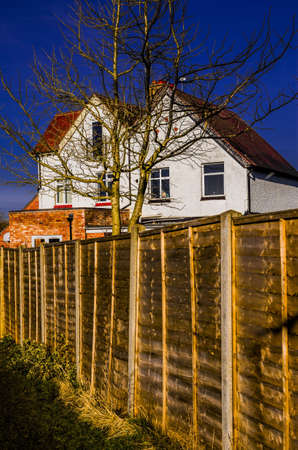Understanding Shared Boundaries in the UK
When it comes to living harmoniously with your neighbours, understanding shared boundaries is key. In the UK, a shared boundary typically refers to the dividing line or structure—such as a fence, wall, or hedge—that separates two adjoining properties. These physical demarcations serve not only as practical markers but also play an important role in defining legal responsibilities and neighbourly relations.
Most homes in Britain feature some form of boundary marker. The classic wooden panel fence is a common sight, particularly in suburban and urban areas. These are often supported by concrete or timber posts and may be complemented by trellises for additional privacy or decorative purposes. In older properties, you might encounter brick walls or traditional stone walls, especially prevalent in rural regions or along historic terraces. Hedges—be they evergreen or deciduous—also frequently serve as living boundaries, providing both a green aesthetic and privacy.
The exact position and maintenance responsibility for these structures can sometimes cause confusion and disputes if not properly understood. Generally, property deeds will clarify where the boundary lies and who is responsible for upkeep. However, over time, these lines can become blurred due to changes in landscaping, extensions, or simply unclear documentation. That’s why it’s essential for homeowners to familiarise themselves with the types of boundaries present on their land, as well as the legal framework that governs them.
2. Legal Responsibilities and Boundary Ownership
Understanding who is responsible for a boundary feature, such as a fence or wall, is crucial for maintaining good relations between neighbours in the UK. The legal framework surrounding boundary ownership can sometimes be complex, especially with older properties where records may not be clear. This section provides an overview of the relevant laws, how to determine ownership, and why it’s important to check your property’s deeds and historical documents before making any changes to shared boundaries.
UK Laws on Boundaries
The law in England, Wales, Scotland, and Northern Ireland generally states that property boundaries are determined by the title deeds and land registry plans. However, these documents do not always provide a definitive answer, especially if boundaries have shifted over time or if informal agreements have been made between previous owners. In many cases, responsibility for maintenance of fences or walls is not strictly outlined in the deeds, leading to disputes.
How to Identify Boundary Ownership
To determine who owns or is responsible for a boundary feature:
- Check Title Deeds: Look for any mention of responsibility for fences or walls. Sometimes, deeds will use symbols like “T-marks” to indicate ownership.
- Land Registry Plans: These may help clarify boundary lines but rarely specify maintenance responsibilities.
- Historical Documents: Old conveyances or correspondence may give clues about historic agreements.
- Verbal Agreements: If previous owners agreed on a maintenance arrangement, this might still apply—although it’s best to get such agreements in writing.
Common Terminology in Property Deeds
| Term | Description |
|---|---|
| T-mark | A symbol often used on plans; the stem of the “T” points towards the owner responsible for that side of the boundary. |
| Party Wall | A wall that stands on the land of two (or more) owners and forms part of a building. |
| Adverse Possession | A legal principle allowing someone who has occupied land without permission for a certain period to claim ownership. |
The Importance of Documentation
Before carrying out any repairs, replacements, or alterations on a shared boundary, always consult your property deeds and discuss with your neighbour. If there’s any uncertainty regarding ownership or responsibility, consider seeking advice from a solicitor or contacting HM Land Registry. Keeping thorough records can prevent misunderstandings and help ensure that all work complies with local regulations and preserves neighbourly harmony.

3. Best Practices for Fence Maintenance and Upkeep
Maintaining a shared fence is not just about preserving appearances—it’s also about ensuring safety, privacy, and good relations with your neighbours. In the UK, proper upkeep of boundary fences can prevent disputes and costly repairs down the line. Here’s how to keep things in top shape while keeping communication open and friendly.
Regular Inspections
Conduct seasonal checks for signs of damage such as rotting wood, loose posts, rusted metal, or leaning panels. Early detection allows you to tackle minor issues before they escalate. It’s wise to walk the length of the fence together with your neighbour if possible, so both parties agree on what needs attention.
Routine Cleaning
Remove any debris, overgrown vegetation, or moss that may cause dampness or deterioration over time. A gentle scrub with soapy water helps wooden fences last longer and keeps them looking tidy. For metal fences, check for rust spots and treat them promptly.
Repairs and Painting
If you notice broken boards or damaged posts, agree on a repair plan with your neighbour. Use weather-resistant materials suited to the UK climate. Regular painting or staining protects wood from rain and extends its life. Always discuss colour choices beforehand—this keeps everyone happy and avoids misunderstandings.
Communication is Key
Open dialogue is essential when dealing with shared boundaries. Before starting any maintenance work, have a chat over a cuppa or drop a friendly note through the door outlining your plans. Agree on timings and costs if needed; consider splitting expenses fairly if repairs benefit both parties.
Safety First
When carrying out repairs, ensure the area is safe—use appropriate tools, wear protective gear, and avoid working alone if possible. If professional help is required (for example, for tall or unstable fences), agree on a reputable local tradesperson together.
Avoiding Disputes
Document any agreements in writing—an email chain often suffices—to keep things clear and amicable. Remember, well-maintained fences don’t just mark property lines; they help build lasting neighbourly trust.
4. Resolving Disputes Amicably
Disagreements over shared boundaries are common in the UK, but a neighbourly approach can often prevent matters from escalating. Addressing concerns early and openly is key to maintaining good relations and avoiding unnecessary stress or legal expenses. Here’s practical advice on how to handle disputes regarding fences and boundaries in a way that respects both parties and adheres to best practices.
Communication and Negotiation
Start by having a polite conversation with your neighbour. Express your concerns calmly, listen to their perspective, and try to find common ground. It’s helpful to bring along any relevant documents, such as property deeds or Land Registry plans, to clarify the facts together. If you reach an agreement, consider putting it in writing for future reference.
Local Mediation Services
If direct communication doesn’t resolve the issue, local mediation services can provide impartial support. Many councils across the UK offer community mediation, where a neutral third party helps both sides find an acceptable solution without resorting to legal action. Mediation tends to be quicker, less expensive, and less adversarial than court proceedings.
When to Seek Legal Advice
Sometimes, despite best efforts, disputes cannot be resolved informally. In such cases, seeking professional legal advice may be necessary—especially if boundary lines are unclear or significant property alterations are involved. A solicitor experienced in property law can help interpret deeds and survey reports, and advise on the next steps.
| Resolution Method | Best For | Pros | Cons |
|---|---|---|---|
| Informal Negotiation | Minor misunderstandings | Low cost, preserves relationship | May not resolve complex issues |
| Mediation | Ongoing disagreements | Impartial help, confidential | Both parties must agree to attend |
| Legal Advice/Court | Legal uncertainty or large disputes | Definitive resolution | Costly, time-consuming, may strain relations further |
Treating neighbours with respect and patience goes a long way towards resolving boundary disputes amicably. Remember: it’s not just about the fence—it’s about fostering good neighbourly relations for years to come.
5. Safety, Security, and Boundary Etiquette
Ensuring your boundary fence is both safe and secure is essential for peace of mind and harmonious neighbourly relations. A well-maintained fence deters trespassers, keeps pets and children safely within your garden, and provides a clear demarcation of property lines. When considering upgrades or repairs, use robust, weather-resistant materials commonly used in the UK such as treated timber or concrete posts to withstand our variable climate. Check that all panels are properly fixed and free from splinters or protruding nails to avoid accidents.
Respecting Privacy
Privacy is a cornerstone of good neighbourliness. If you’re installing new fencing, discuss plans with your neighbour before work begins—especially if the fence will be higher than two metres, which may require planning permission under UK law. Choose designs that provide adequate screening without feeling oppressive; traditional featheredge or closeboard panels are popular choices for British gardens. For added privacy without sacrificing aesthetics, consider planting hedges alongside fences, which can also encourage wildlife.
Security Measures
Security should never come at the expense of courtesy. Fit gates with sturdy locks and hinges, but ensure shared access paths remain usable for both parties. Avoid attaching sharp objects like barbed wire on top of domestic fences as this may contravene local by-laws and create tension with neighbours. Instead, opt for trellis toppers or prickly shrubs to enhance security in a neighbour-friendly way.
Maintaining Good Relations
Regular maintenance not only extends the life of your fence but also signals respect for those living next door. Keep your side tidy by clearing away leaves, moss, and any debris that could cause dampness or rot. If a problem arises—like storm damage or leaning panels—communicate promptly and work together on repairs if the boundary is shared. Finally, always ask permission before painting or altering a fence that isn’t solely yours; small courtesies go a long way in maintaining good neighbours.
6. Sustainable and Eco-Friendly Fencing Options
When it comes to shared boundaries, modern UK homeowners are increasingly looking for solutions that not only comply with local laws but also support environmental sustainability. Choosing the right fencing materials and designs is more than just a personal preference—it contributes to the wellbeing of the entire community. Here’s how you can make eco-friendly choices without compromising on legal requirements or neighbourly relations.
Understanding Local Regulations
Before you start any fencing project, it’s essential to check with your local council regarding planning permissions and height restrictions. Many areas in the UK have guidelines on what materials are acceptable, especially in conservation areas or near listed buildings. Ensuring compliance will help avoid disputes and support community standards.
Eco-Friendly Material Choices
Recycled and Reclaimed Wood
Opting for FSC-certified timber or reclaimed wood reduces demand for virgin resources. Make sure any wood used is treated with environmentally safe preservatives, which also helps extend the life of your fence—a win-win for both nature and your budget.
Bamboo and Composite Materials
Bamboo grows quickly and is a renewable resource, making it an excellent choice for green fencing. Composite fencing, made from recycled plastics and wood fibres, offers durability with low maintenance while diverting waste from landfill.
Designs That Benefit Wildlife and Neighbours
Living Fences
Hedges made from native species like hawthorn or beech not only mark boundaries but also provide habitats for birds and pollinators. They’re less likely to cause disputes as they can act as natural sound barriers while enhancing garden privacy.
Permeable Designs
Picket fences or woven willow panels allow air and light to pass through, supporting plant growth on both sides of the boundary and fostering a sense of openness between neighbours.
Maintenance Matters
Eco-friendly doesn’t stop at installation. Regular checks for rot, damage, or invasive plants will ensure your fence remains sturdy and attractive for years—helping maintain good relationships with those living next door.
Community Wellbeing First
Ultimately, choosing sustainable fencing isn’t just about personal ethics—it’s about respecting the shared environment and ensuring everyone enjoys a safer, greener neighbourhood. By opting for responsible materials and neighbour-friendly designs, you’ll be doing your bit for the planet while setting a positive example in your community.

